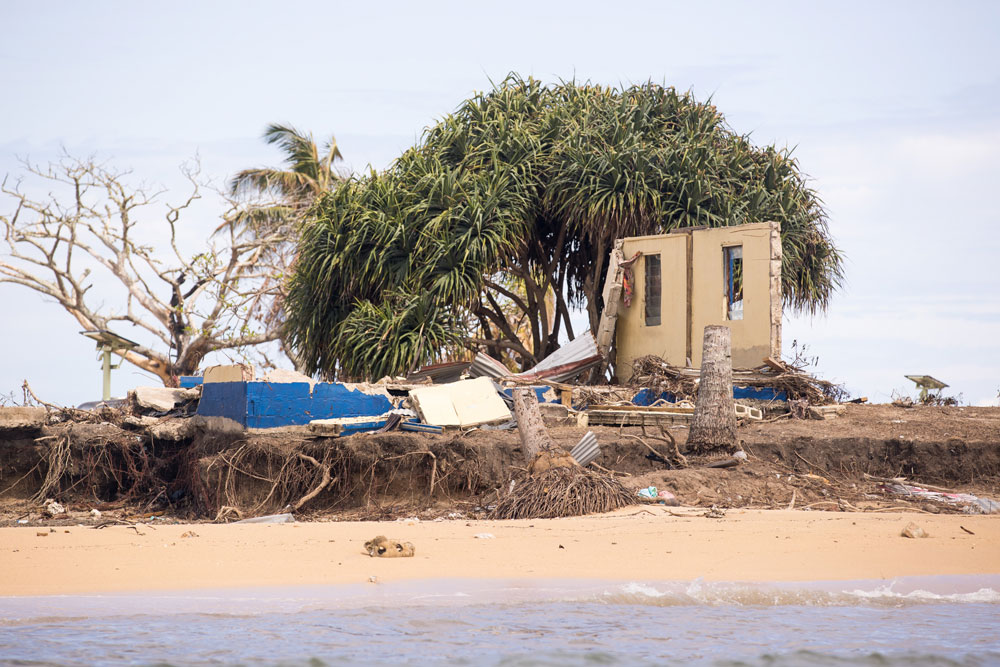Christmas is a time that might include thinking of celestial things: the star of Bethlehem, three Wise Men of Persia bearing gold, myrrh and frankincense and perhaps other atmospheric matters. In Australia in 2022 we saw pink sunsets. The evening of 14 December 2022 was one such occasion.
Those who follow the heavens might see this as a sign of an auspicious new year present for us all.
The Tonga Hunga volcanic eruption on 15 January 2022 triggered two types of tsunamis: an ocean tsunami with a displacement of large volumes of water and a meteotsunamis (meteo from Greek meaning raised up or lofty) caused by fast-moving pressure disturbances in the atmosphere.
In an article published by NASA (‘NASA mission finds Tonga volcanic eruption effects reach space’, 10 May 2022) noted that ‘scientists found that in the hours after the eruption, hurricane-speed winds and unusual electric currents formed in the ionosphere – Earth’s electrified upper atmospheric layer at the edge of space.’ The article also notes; ‘When the volcano erupted, it pushed a giant plume of gases, water vapor, and dust into the sky. The explosion also created large pressure disturbances in the atmosphere, leading to strong winds. As the winds expanded upwards into thinner atmospheric layers, they began moving faster. Upon reaching the ionosphere and the edge of space, ICON clocked the windspeeds at up to 450 mph – making them the strongest winds below 120 miles altitude measured by the mission since its launch. In the ionosphere, the extreme winds also affected electric currents.’
A report from New Zealand scientists reveals the magnitude of the Tonga Hunga volcanic eruption (‘”Like a shotgun”: Tongan eruption is largest ever recorded‘, 21 November 2022).
The ionosphere stretches roughly 50 to 400 miles above Earth’s surface, right on the degree of space. It is the boundary lower atmosphere where humans can operate to the vacuum of space. Another web article from NASA outlines 10 features of the ionosphere. One of the points made in the article is that only in the past 15 years has NASA realised the impact of space weather on the earth. Space weather is not the activity of the sun.
If the reader wishes to read a commentary on the activity of the sun and its impact on earth look to one of many articles on the web (2022) – A solar storm is coming. Should we worry? – and an article from Harvard about solar activity impacting volcanic activity on earth (2018) – A solar-terrestrial effect strongly influences volcanism.
The question is what impact Tonga Hunga might have on earth’s weather or climate? There is little if any commentary to be found on the matter. But historical events of a similar nature are available.
In 1815 Mount Tambora a volcano on an island located in Indonesia erupted recording the most powerful volcanic eruption in recorded history. It was recorded as a Volcanic Explosivity Index (VEI) of 7. (Tonga Hunga was recorded as a VEI 5-6. There has not been recorded a VEI of 8 or 9.) The ash from the eruption column dispersed around the world and lowered global temperatures. The year of 1816 is also known as the ‘Year Without a Summer’. There were extreme weather events and famines.
In 1883 eruption of the island of Krakatoa went from May to October with a caldera in August which saw about three quarters of the island and surrounding archipelago destroyed. The Krakatoa VEI was 6. The eruption caused a volcanic winter. A Volcanic winter is caused by large amounts of sulphur dioxide gas entering the stratosphere. In this event this led to an increase of sulfuric acid concentration in high level cirrus clouds. This results in an increase of cud reflectivity which lasted until the sulphur fell to the ground as acid precipitation. The increase atmospheric sulphur can create pink sunsets. The atmospheric optical effects of Krakatoa were well reported across the globe.
Apart from the observation of the bright and delicate pink sunset all the information in this article has been sourced from the web. There is no contemporaneous commentary apparent from any Australian Government agencies. This is interesting when one looks at the following:
| Volcano | VEI | Material ejected (cubic kilometres) | Climatic impact |
| Mount Tambora | 7 | 160 – 213 km3 | Year without a Summer |
| Krakatoa | 6 | 25 km3, 6 cubic miles. Cataclysmic explosion heard 3600 kms away. | A volcanic winter |
| Tonga Hunga | 5-6 | 10 km3 Debris 40 kms into the atmosphere | Yet to be determined |

